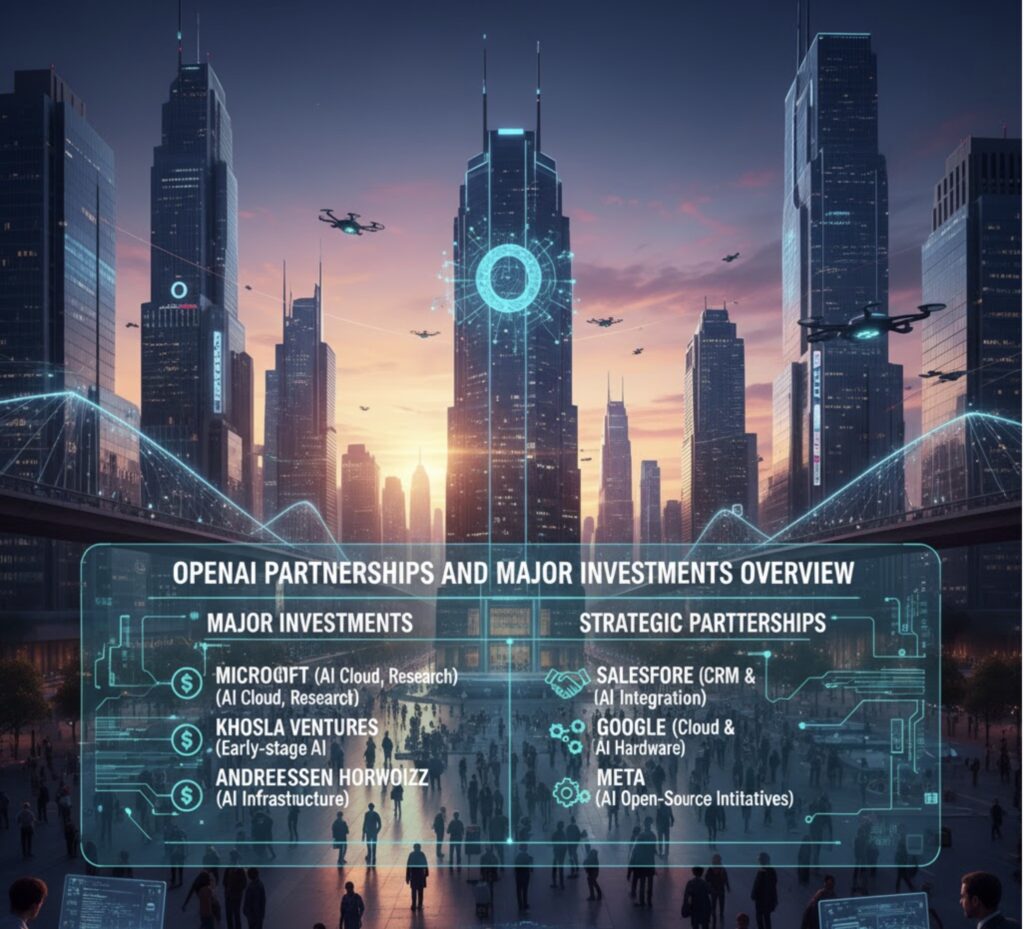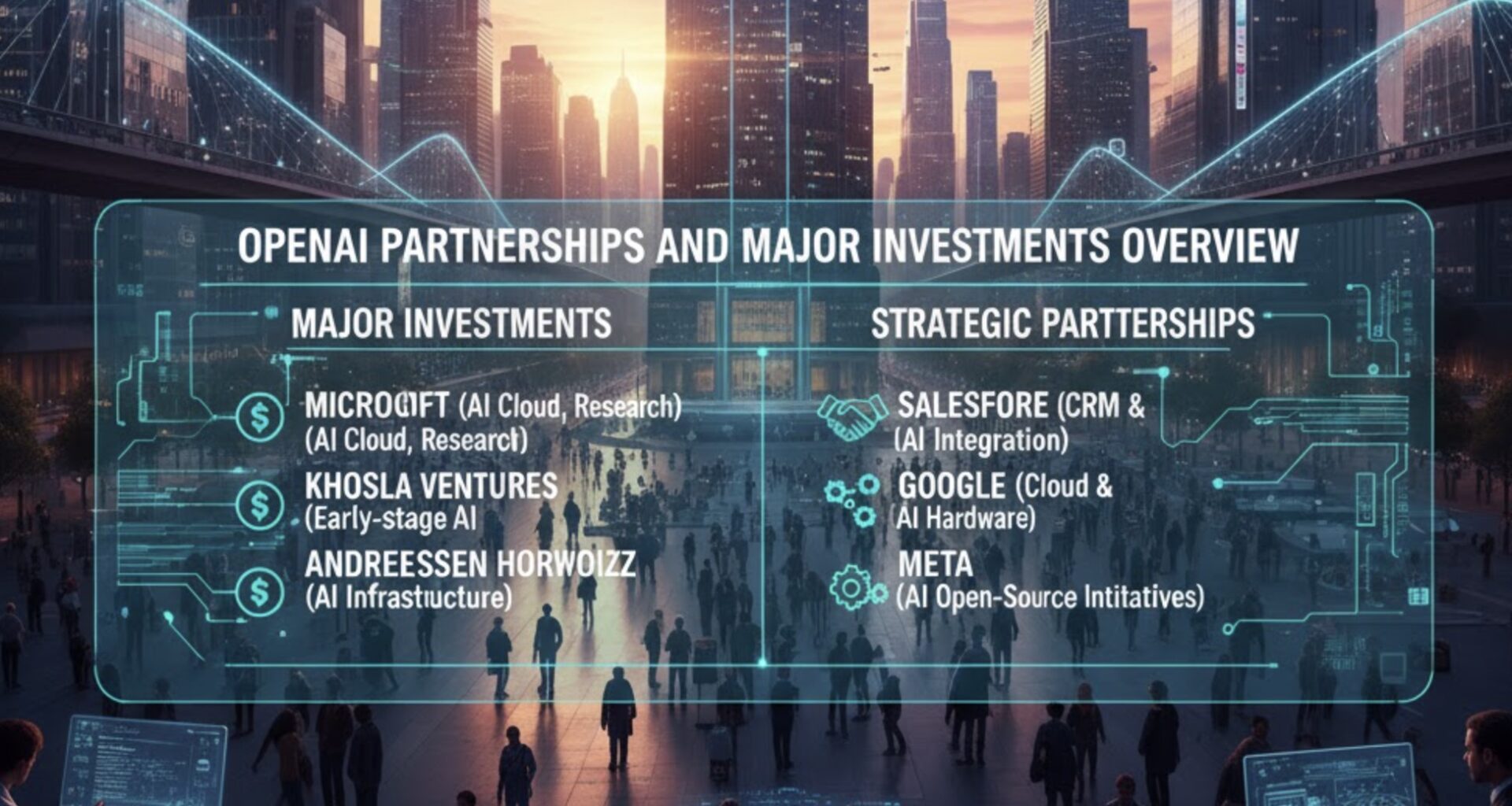Summary of Findings
OpenAI has recently engaged in several high-profile partnerships and financial arrangements involving NVIDIA, AMD, Oracle, and other investors. Key findings include:
- NVIDIA’s $100 Billion Commitment: In September 2025, NVIDIA and OpenAI announced a strategic partnership to build 10 gigawatts of AI supercomputing capacity (millions of GPUs) for OpenAI’s next-generation models. To support this, NVIDIA intends to invest up to $100 billion in OpenAI, deployed progressively as each 1 GW of data center capacity comes onlinenvidianews.nvidia.comnvidianews.nvidia.com. This investment is aimed at financing the massive infrastructure (dubbed the “Stargate” project) needed to train and run advanced AI systems.
- OpenAI’s Stake in AMD (10% Warrant): In October 2025, AMD signed a multi-year deal to supply OpenAI with hundreds of thousands of AI chips (roughly 6 GW of GPU capacity) beginning in 2026. As part of this deal, AMD granted OpenAI a warrant to purchase up to ~10% of AMD’s stock (approximately 160 million shares) at a nominal price of $0.01 per sharereuters.comreuters.com. The warrant vests in tranches tied to project milestones, giving OpenAI an ownership stake in AMD if it fully executes the planned chip deploymentsreuters.comreuters.com. This arrangement both secures OpenAI’s chip supply and aligns the two companies’ incentives.
- Partnerships with Oracle: Oracle is a key cloud partner for OpenAI. In mid-2024, OpenAI, Microsoft, and Oracle announced a collaboration to extend the Azure AI platform onto Oracle Cloud Infrastructure, providing OpenAI with additional cloud capacity for its AI workloadsoracle.com. By 2025, Oracle became deeply involved in OpenAI’s “Stargate” AI infrastructure initiative: in July 2025 OpenAI and Oracle agreed to develop 4.5 GW of new AI data center capacity together, a partnership valued at over $300 billion over five yearsopenai.com. Oracle is building multiple U.S. data center sites for OpenAI and was an initial equity investor in the Stargate project (alongside SoftBank and others), making Oracle one of OpenAI’s most significant infrastructure collaboratorsreuters.comreuters.com.
- The $500 Billion “Stargate” Initiative: Stargate is the code name for an enormous AI infrastructure project launched in January 2025. It is a confirmed plan (backed by official announcements) to invest $500 billion over four years in new AI supercomputing facilities for OpenAIopenai.com. The project is structured as a new venture jointly led by SoftBank (as lead financier) and OpenAI (managing operations), with initial equity funding from SoftBank, OpenAI, Oracle, and Abu Dhabi’s MGXopenai.com. SoftBank’s Masayoshi Son serves as Stargate’s chairman. The goal is to build about 10 GW of cutting-edge data center capacity in the U.S. to ensure leadership in AI and support OpenAI’s push toward artificial general intelligencereuters.com. Key technology partners include NVIDIA (providing state-of-the-art GPU systems), Microsoft (Azure cloud services), Arm (chip architectures), and Oracle, among othersopenai.comreuters.com. The Stargate program has already broken ground – for example, a flagship campus in Texas (Abilene) is operational, and by September 2025 planned capacity had reached 7 GW with ~$400 billion funded, putting it ahead of schedule to fulfill the full $500 billion, 10 GW commitmentopenai.comopenai.com. International expansions are also underway (e.g. a Stargate Norway data center and a UAE project) involving additional partnersreuters.comreuters.com. In summary, “Stargate” is a massive, multi-party effort – led by OpenAI and SoftBank with Oracle, NVIDIA, and others – to build the world’s most advanced AI computing infrastructure, and it has been publicly announced and is in progress.
- OpenAI’s Valuation (~$500 Billion): OpenAI’s valuation has skyrocketed in recent funding rounds. As of October 2025, OpenAI was valued around $500 billion, according to multiple reports. This valuation was reached after a secondary share sale in which current and former OpenAI employees sold roughly $6.6 billion worth of stock to a consortium of investors including SoftBank, Thrive Capital, Dragoneer, Abu Dhabi’s MGX, and T. Rowe Pricereuters.comreuters.com. The $500 billion figure marks a sharp increase from an earlier ~$300 billion valuation in 2025, reflecting OpenAI’s rapid growth in users and revenuereuters.com. (Notably, SoftBank had also invested in a prior $40 billion primary funding roundreuters.com.) While $500 billion is a staggering number, it has been cited in credible outlets (e.g. Reuters) based on these recent share transactions, making OpenAI one of the world’s most valuable privately-held tech companies.
Below, each of these points is explained in detail with sources from major news publications and official announcements.

NVIDIA’s $100 B Investment in OpenAI
OpenAI and NVIDIA have established a major partnership to expand AI computing capacity. On September 22, 2025, NVIDIA and OpenAI jointly announced plans to deploy at least 10 gigawatts of NVIDIA GPU-based systems for OpenAI’s next-generation AI modelsnvidianews.nvidia.com. This scale – on the order of millions of GPUs – is intended to support OpenAI’s efforts to develop more advanced AI, including work toward superintelligence. To enable this ambitious build-out, NVIDIA pledged to invest up to $100 billion in OpenAI, provided incrementally as the infrastructure is built out in phasesnvidianews.nvidia.comnvidianews.nvidia.com. The first 1 GW of capacity is expected to come online in late 2026 on NVIDIA’s new “Vera Rubin” supercomputing platformnvidianews.nvidia.com.
“NVIDIA intends to invest up to $100 billion in OpenAI progressively as each gigawatt is deployed.” nvidianews.nvidia.com
This $100 billion investment is not a traditional lump-sum equity infusion, but rather part of a strategic infrastructure partnership. Essentially, NVIDIA is committing huge resources (capital, hardware, and expertise) to ensure OpenAI can access the compute power it needs. NVIDIA’s CEO Jensen Huang framed this as “the next leap forward – deploying 10 GW to power the next era of intelligence”nvidianews.nvidia.com. OpenAI’s CEO Sam Altman likewise emphasized that “everything starts with compute” for future AI breakthroughsnvidianews.nvidia.com.
In summary, NVIDIA’s promised investment is aimed at co-developing AI supercomputers with OpenAI. It underscores NVIDIA’s confidence in OpenAI (NVIDIA and OpenAI have a longstanding relationship since 2016) and also serves NVIDIA’s interest by driving demand for its chips. This arrangement was widely reported; for example, Time noted that “Nvidia recently invested $100 billion in OpenAI”, describing it as a “vertical integration” of AI capabilitiestime.com. The nature of the investment is tied to infrastructure – NVIDIA will likely provide hardware, technology, and funding to build data centers, and in return OpenAI secures preferred access to NVIDIA’s cutting-edge GPUs at massive scalenvidianews.nvidia.com. This partnership complements OpenAI’s other collaborations (with Microsoft, Oracle, SoftBank, etc.) under the broader Stargate initiativenvidianews.nvidia.comnvidianews.nvidia.com.
OpenAI’s 10% Stake in AMD (Chip Supply Deal)
OpenAI’s relationship with Advanced Micro Devices (AMD) escalated in late 2025 via a major chip supply deal that also grants OpenAI an equity stake in AMD. On October 6, 2025, Reuters reported that AMD will supply OpenAI with hundreds of thousands of AI chips over several years, in a deal expected to generate “tens of billions of dollars in annual revenue” for AMDreuters.comreuters.com. The hardware commitment is enormous – equivalent to roughly 6 GW of GPU computing capacity to be delivered starting in the second half of 2026reuters.com.
Crucially, as part of this agreement, AMD issued OpenAI a warrant to purchase up to 160 million AMD shares at $0.01 each, which is roughly a 10% ownership stake in the chipmakerreuters.comreuters.com. This warrant vests in phases contingent on OpenAI meeting certain performance and purchase milestones over the course of the chip supply dealreuters.com. In other words, if OpenAI follows through on buying and deploying the agreed-upon volume of AMD processors, it can eventually exercise the warrant and acquire AMD stock essentially for free (one cent per share).
“Deal includes [a] warrant for OpenAI to buy up to 10% [of] AMD [at] 1 cent/share… The warrant vests in tranches based on milestones that the two companies have agreed on.”reuters.com
This innovative arrangement aligns incentives: AMD secures a marquee customer and potentially over $100 billion in new revenue across OpenAI and similar customersreuters.com, while OpenAI gains a significant stake in a major chip supplier, giving it a financial upside if AMD’s AI chip business thrivesreuters.comreuters.com. The news of the deal caused AMD’s stock to surge over 30% in a day, reflecting investor excitementreuters.com.
How and when was this stake acquired? The deal (and associated warrant) was struck in October 2025, formalized as a multi-year partnership. OpenAI does not immediately own 10% of AMD; rather, it has the option to obtain that stake by fulfilling the partnership terms. The low exercise price (1¢) indicates that this is essentially a performance grant — a form of strategic investment from AMD’s side to solidify the alliance. If OpenAI maximizes the warrant, it would become one of AMD’s largest shareholders. This is an unusual structure for a customer-supplier relationship, underlining how critical AI chips are and how eager AMD is to compete with NVIDIA for OpenAI’s businessreuters.com. Analysts have called the deal “transformative” for AMD, validating its technology in AI workloadsreuters.com.
In summary, yes – OpenAI can own up to ~10% of AMD through this deal, obtained via a warrant issued in October 2025 as part of a major GPU supply agreementreuters.com. The stake will be realized over time as OpenAI builds out the agreed 6 GW of AMD-based computing capacity.
OpenAI–Oracle Collaboration
Oracle Corporation has emerged as a significant cloud and infrastructure partner for OpenAI. There are two primary facets to the OpenAI–Oracle relationship:
- Cloud Infrastructure Partnership (Capacity Extension): In June 2024, Oracle announced that OpenAI selected Oracle Cloud Infrastructure (OCI) to extend its Microsoft Azure-based AI platformoracle.com. This three-way partnership (Oracle, Microsoft, OpenAI) essentially allowed OpenAI to use Oracle’s cloud data centers alongside Microsoft Azure to meet surging demand. Oracle’s press release highlighted that OCI’s AI superclusters – offering tens of thousands of NVIDIA GPUs with high-speed networking – would provide additional capacity for OpenAIoracle.comoracle.com. Sam Altman (OpenAI’s CEO) said OCI “will extend Azure’s platform and enable OpenAI to continue to scale”oracle.com. For Oracle, securing OpenAI as a cloud customer was a coup; Oracle’s Larry Ellison boasted that “leaders like OpenAI are choosing OCI because it is the world’s fastest and most cost-effective AI infrastructure”oracle.com. This partnership was notable because Microsoft is OpenAI’s primary cloud backer, yet even Microsoft agreed to integrate with Oracle’s cloud to support OpenAI’s needs – reflecting how compute-hungry OpenAI’s models have become. In practical terms, OpenAI workloads (like training advanced GPT models) can be deployed on Oracle’s cloud data centers, effectively augmenting Azure. This collaboration began in 2024 and signaled Oracle’s entry as a key infrastructure provider for OpenAI.
- Stargate Data Center Joint Venture: In 2025, Oracle’s role deepened through OpenAI’s Stargate project (detailed in the next section). Oracle is one of the founding partners and investors in Stargate, which aims to build massive AI data center campuses. In July 2025, OpenAI and Oracle signed an agreement to develop up to 4.5 GW of additional Stargate capacity in the United Statesopenai.com. This Oracle–OpenAI deal alone represents over $300 billion of investment planned over five years between the two companiesopenai.com. Oracle committed to construct at least three large-scale AI compute sites (including locations in Texas and New Mexico) as part of Stargate’s expansionreuters.com. By September 2025, Oracle, OpenAI, and SoftBank jointly announced five new U.S. data center sites for Stargate, citing that Oracle’s projects (plus those with CoreWeave) brought the initiative to 7 GW planned capacity and put it on track for the full $500 billion deployment ahead of scheduleopenai.comopenai.com. Oracle’s cloud infrastructure (OCI) is being used to host these OpenAI supercomputing centers; for instance, Oracle’s flagship Stargate campus in Abilene, Texas, was already operational on Oracle Cloud and running NVIDIA’s latest GPUs as of mid-2025openai.com.
Oracle’s deep involvement indicates a close collaboration with OpenAI: Oracle is not only selling cloud capacity but co-investing in new facilities. Oracle’s CEO Safra Catz and CTO Larry Ellison have openly aligned Oracle’s future with generative AI demand, and the OpenAI partnership is a centerpiece of that strategy. In sum, OpenAI and Oracle are partnering both financially and technologically to scale AI infrastructure. Oracle provides its expertise in enterprise data centers and cloud services, while OpenAI provides the AI workloads (and, via Stargate, shares in the investment). This partnership was somewhat unexpected in the AI landscape (where Microsoft and Google have dominated); it drew attention from analysts and media as a bold move by Oracle to become “a critical supplier to OpenAI”wheresyoured.at. Indeed, TechCrunch noted that OpenAI committed to spend around $60 billion/year on Oracle Cloud capacity as part of this dealtechcrunch.com – a staggering sum illustrating how significant Oracle’s role has become.
In conclusion, OpenAI and Oracle have a robust collaboration: Oracle is both an investor (infrastructure partner via Stargate) and a service provider (cloud capacity for OpenAI’s models). This partnership has been confirmed through official press releases and large-scale projects underway in 2024–2025.
The “Stargate” $500 Billion AI Infrastructure Project
One of the most remarkable developments in OpenAI’s recent history is the creation of “Stargate,” a huge investment initiative to build out AI supercomputing infrastructure. This project has been officially announced and is in progress, involving several major companies and massive capital commitments.
- What is Stargate? Stargate is a new company/joint venture formed in January 2025 with the mission to invest $500 billion over four years in state-of-the-art AI infrastructure for OpenAIopenai.com. The name “Stargate” refers to the idea of opening a gateway to advanced AI capabilities via unprecedented compute power. The plan is to construct approximately 10 gigawatts of data center capacity dedicated to AI – an almost unthinkably large cluster (for context, 10 GW of data centers would consume as much power as several million homes)reuters.comreuters.com. These data centers will host the latest AI hardware (NVIDIA GPUs and other accelerators) to train and run next-generation AI models, including efforts toward artificial general intelligence. The project’s scale and name were first revealed by OpenAI and SoftBank in January 2025, and it has since been a centerpiece of the AI industry’s growth plans.
- Who is involved? Stargate is a collaborative effort led by OpenAI and SoftBank. According to OpenAI’s announcement, the initial equity funders of Stargate are SoftBank, OpenAI, Oracle, and MGX (Abu Dhabi)openai.com. SoftBank (the Japanese tech investment giant helmed by Masayoshi Son) is the lead investor, providing a large portion of the financing (“financial responsibility”), while OpenAI handles “operational responsibility” – essentially overseeing how the infrastructure is deployedopenai.com. Masayoshi Son serves as Stargate’s chairman, signaling SoftBank’s heavy involvementopenai.com. Oracle and MGX (the UAE-based investment firm) are co-investors, indicating public-private collaboration. In addition, NVIDIA, Microsoft, and Arm Holdings are listed as key technology partners in the projectopenai.com. NVIDIA is supplying its top-tier AI chips and systems; Microsoft (an early OpenAI partner) continues to provide Azure cloud support and likely funding or expertise; Arm is contributing its chip architecture know-how (the initiative prominently features Arm-based designs, such as NVIDIA’s Grace Hopper superchips, instead of x86 chips)reuters.comreuters.com. Other partners and suppliers have joined as the project expands: for example, CoreWeave (a GPU cloud provider) is contributing capacity via separate deals with OpenAIreuters.com; Samsung and SK Hynix have signed on to supply memory chips and even potentially host some data centers in South Koreareuters.com; Foxconn is set to manufacture data center equipment for Stargate in an Ohio facility with SoftBankreuters.com; and international offshoots like Stargate Norway (in partnership with Nscale and Aker ASA) and Stargate UAE (with G42 in the UAE) are underway to extend the project globallyreuters.comreuters.com. In short, Stargate is a sprawling alliance of tech companies, investors, and even governments, all coalescing around OpenAI’s infrastructure needs.
- Purpose and Confirmation: The stated purpose of the $500 billion Stargate investment is to dramatically scale up AI computation capacity in a short time frame, ensuring that the United States and its allies maintain leadership in AI advancementopenai.com. OpenAI has been transparent that current computing capabilities are a bottleneck for developing more powerful AI (like GPT-5 and beyond). Stargate’s infrastructure will power both the training of new AI models and the deployment of AI services. The project is also framed in terms of economic and national security benefits: OpenAI’s announcement emphasized “re-industrialization of the United States” and providing a “strategic capability to protect national security” as outcomes of building these data centersopenai.com. U.S. officials have taken interest as well – Reuters noted Stargate is “central to Washington’s push for dominance in the field [of AI]”reuters.com. The project is confirmed by multiple credible sources: OpenAI’s official blog post introduced Stargate and outlined its funding and goalsopenai.comopenai.com, and follow-up press releases from OpenAI detail progress (such as new sites and partnerships)openai.comopenai.com. Major media like Reuters, the Wall Street Journal, and others have also reported extensively on Stargate as a real, active initiative (not just a rumor). For example, Reuters summarized that “Stargate, a $500 billion AI infrastructure initiative… will be developed by OpenAI, SoftBank and Oracle” with 10 GW capacity targetreuters.com.
- Current Status: As of late 2025, the Stargate project is well underway. OpenAI initially committed $100 billion to kick-start the effort immediately in 2025reuters.com (likely funded by SoftBank and partner contributions). Construction has started at multiple sites. The first flagship Stargate campus in Abilene, Texas is already online and delivering compute power via Oracle’s cloud infrastructureopenai.com. By September 2025, a total of six U.S. sites (including Texas, New Mexico, Ohio, etc.) were announced, representing nearly 7 GW of planned capacity and ~$400 billion in investment securedopenai.comopenai.com. This puts Stargate ahead of schedule to reach the full $500 billion / 10 GW goal by the end of 2025openai.com. Additionally, international expansion is taking shape: OpenAI is launching its first European Stargate center in Norway (a $1 billion project in partnership with local firms, slated to open in 2026)reuters.com, and a “Stargate UAE” project in the Middle East (backed by the UAE’s G42 and brokered at a national level) will create the largest AI data center outside the U.S.reuters.com. NVIDIA’s hardware is a backbone of these deployments – one report mentions an initial installment of 100,000 Nvidia chips in Norway with potential 10× expansionreuters.com. All these indicate that Stargate is not just proposed but actively being executed, with real sites and hardware coming online.
In summary, Stargate is a monumental $500 billion investment project led by OpenAI and partners to build the world’s most advanced AI computing network. It has been confirmed by official press releases and reporting, and it involves a who’s-who of tech industry players (SoftBank, Oracle, NVIDIA, Microsoft, etc.) collaborating to achieve a shared vision: providing OpenAI (and the U.S.) with unparalleled AI infrastructure. The name “Stargate” itself has entered common use in discussions about AI policy and industry, symbolizing the scale of resources being poured into AI developmenttechtarget.com.
OpenAI’s Valuation and Recent Funding Rounds (≈$500 Billion)
OpenAI’s rapid growth has been matched by surging investor interest and valuations. As of October 2025, OpenAI is indeed estimated to be valued around $500 billion, making it one of the most valuable AI companies in the world. This figure comes from recent funding transactions and has been reported by major financial news outlets:
- Secondary Share Sale to Reach $500 B Valuation: In early October 2025, Reuters reported that OpenAI’s valuation reached $500 billion after a deal in which current and former employees sold approximately $6.6 billion worth of OpenAI shares to outside investorsreuters.com. This was a secondary sale (meaning the money went to existing shareholders cashing out some equity, not directly into OpenAI’s coffers) but it set a new market valuation benchmark for the company. The buyer consortium in this deal included top-tier global investors: Thrive Capital, SoftBank, Dragoneer Investment Group, Abu Dhabi’s MGX (the UAE sovereign-backed tech fund), and T. Rowe Price, among othersreuters.com. The transaction was done at a price that implied the $500 billion valuation, which was up from around $300 billion valuation earlier in 2025reuters.com. This dramatic jump underscores how quickly OpenAI’s business and strategic importance have grown — in fact, Reuters noted the $4.3 billion in revenue OpenAI generated in the first half of 2025 was already 16% more than all of 2024, highlighting explosive growthreuters.comreuters.com.
- SoftBank and Others Investing: It’s worth noting that this $500 billion valuation event was part of a broader wave of investment. OpenAI had authorized over $10 billion of share sales on the secondary market, and the $6.6 billion that traded hands was likely a portion of thatreuters.com. The presence of SoftBank is particularly notable. SoftBank was reported to be leading or heavily participating in a major investment in OpenAI; Reuters mentioned a “$40 billion primary funding round” for OpenAI in which SoftBank was involvedreuters.com. (This could refer to new capital being injected directly into OpenAI at a ~$300–400 billion valuation before the secondary sale bumped it to $500 billion). In any case, SoftBank’s involvement – along with other big names – lends credibility to the valuation. These investors are betting on OpenAI’s long-term potential (in areas like AI services, licensing, and possibly future AGI breakthroughs). The valuation also reflects the strategic value of OpenAI’s technology (e.g., GPT-4, ChatGPT, and future models) and its partnerships (with Microsoft, etc.).
- Confirmation of Valuation: The $500 billion figure has been cited in multiple reputable sources. Aside from Reuters, publications like The Information (which first detailed OpenAI’s financials) and Wall Street Journal have discussed OpenAI’s fundraising at eye-popping valuations, though some of those reports pegged it in the $80–90 billion range earlier (that was before this latest jump). The Reuters report from Oct 2, 2025 is our best confirmation: “OpenAI… has reached a valuation of $500 billion, following a deal in which current and former employees sold roughly $6.6 billion worth of shares”reuters.com. This suggests the market (at least among private investors) now views OpenAI on par with the world’s largest tech companies by capitalization. For perspective, a $500 billion valuation would make OpenAI larger than Meta (Facebook) was for much of its history, and about half the size of Google or Microsoft – a staggering achievement for a company founded in 2015 as a small research lab.
Therefore, yes – OpenAI is currently valued around $500 billion (as of fall 2025), based on recent share transactions. This valuation has been supported by significant funding rounds and is linked to investors’ expectations of OpenAI’s future prospects. It’s important to note that as a private company, OpenAI’s exact valuation can fluctuate and is not publicly traded; however, the $500 billion figure comes from credible reports and reflects the latest known market estimate for OpenAI’s worthreuters.com.
Sources
- OpenAI & NVIDIA press release on 10 GW partnership and $100 B investment pledgenvidianews.nvidia.comnvidianews.nvidia.com
- Reuters – “AMD signs AI chip-supply deal with OpenAI, shares surge…” (details of AMD–OpenAI deal and 10% warrant)reuters.comreuters.com
- Reuters – “OpenAI hits $500 billion valuation after share sale…” (valuation and investors)reuters.comreuters.com
- OpenAI – “Announcing the Stargate Project” (official blog post, $500 B initiative details)openai.comopenai.com
- OpenAI – “OpenAI, Oracle, and SoftBank expand Stargate…” (Stargate progress update, Oracle partnership)openai.comopenai.com
- Reuters – “Key stakeholders in $500 billion Stargate AI project” (overview of Stargate partners, NVIDIA $100 B mention, etc.)reuters.comreuters.com
- Oracle press release – “OpenAI Selects Oracle Cloud Infrastructure to Extend Azure” (OpenAI–Oracle cloud partnership)oracle.com
- TechCrunch – “Why the Oracle-OpenAI deal caught Wall Street by surprise” (analysis of Oracle partnership, spending commitments)techcrunch.com









